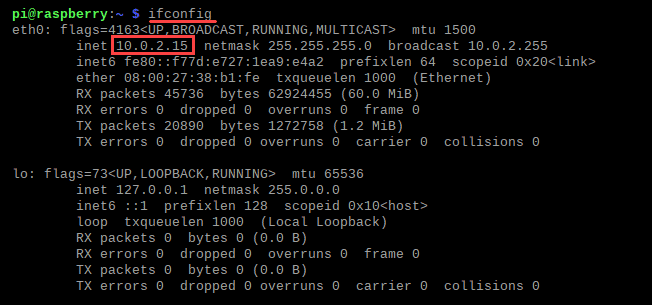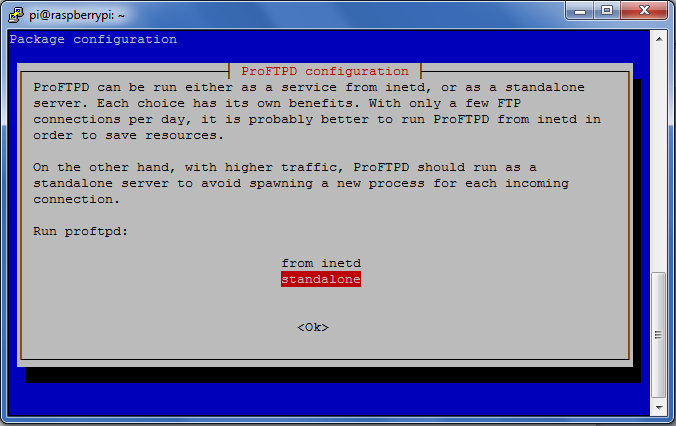

- LINUX RASPBERRY PI FTP SERVER HOW TO
- LINUX RASPBERRY PI FTP SERVER INSTALL
- LINUX RASPBERRY PI FTP SERVER FULL
- LINUX RASPBERRY PI FTP SERVER DOWNLOAD
- LINUX RASPBERRY PI FTP SERVER MAC
You can use many variants of what I use, but matching the basic concepts will be best for beginners. These are the most basic components you'll need to build your own FerretPi.
LINUX RASPBERRY PI FTP SERVER MAC
intentionally change max bandwidth per day, spoof MAC addresses, conceal hostnames) Secondary objectives are for those of you that really want to make something crazy. "Teach" the Pi to automatically avoid detection (e.g. if hard drive is unexpectedly removed and remains removed for five minutes, then format upon remount).
LINUX RASPBERRY PI FTP SERVER FULL
Goals of the FerretPi project: Primary Objectives: - Run an FTP server on a Raspberry Pi with full functionality - Set up automation for file and log management - Apply basic Linux security best practices (such as no root login from SSH, etc) - Construct a reporting system to notify of system changes via SMS or e-mail Secondary Objectives: - Compile a custom hardened Linux OS to run off the Raspberry Pi - Encrypt the storage device with strong non-RSA algorithms - Build a simple self-destructive intrusion detection system (e.g.
LINUX RASPBERRY PI FTP SERVER DOWNLOAD
The server will also run various FTP services that will allow you to download anything you might need on the fly. The server will keep a bulk of it's data on an external hard drive.
LINUX RASPBERRY PI FTP SERVER HOW TO
This Instructable is all about how to make a small, simple, and affordable server with attached storage to download anything you need. You've probably seen quite a few Raspberry Pi projects already, or maybe you've even done a couple and want to try something a little more advanced. You can now reboot the operating system and test the connection in a FTP program, such as FileZilla.I know what you're thinking: "How cool would it be if I had my own Google Drive/SkyDrive/Dropbox that I can use whenever I like?" Or maybe you are just getting into the Maker movement and you think it's the greatest thing since canned bread. Reload the proFTPd service to pick-up the changes made in the configuration file: sudo service proftpd reload This is 60 seconds.Īnd uncomment DefaultRoot so users are ‘jailed’ to their home directories, they will still be able to access files on the USB HDD because of the ‘binded’ folder we created. Now edit the proFTPd configuration file: sudo nano /etc/proftpd/nfĬhange the TimeoutIdle value to 60.
LINUX RASPBERRY PI FTP SERVER INSTALL
Install proFTPd: sudo apt install proftpd Now change the ownership of this folder to the ‘ftp-user’ user: sudo chown ftp-user:ftp-user /home/ftp-user/usb-hdd-storage Edit the ‘fstab’ file so this bind is permanent: sudo nano /etc/fstabĪdd this line to the bottom of the file, it should be below the line which was added in the previous step: /usb-hdd-storage /home/ftp-user/usb-hdd-storage none bind 0 0 Perform a bind to where the USB HDD is mounted. Note: If you need to unmount the drive, run: sudo umount /usb-hdd-storageĬreate a folder in the ‘ftp-user’ home directory, this will be used in the next step to ‘bind’ to the folder we created in /root/usb-hdd-storage: sudo mkdir /home/ftp-user/usb-hdd-storage

To make the USB HDD mount permanently, edit the ‘fstab’ file: sudo nano /etc/fstabĪdd this line to the bottom of the file: /dev/sdaX /usb-hdd-storage ntfs defaults 0 0 You’ll also have to set permissions to ensure the drive can be accessed properly: sudo chmod 775 /usb-hdd-storage This can be found from the ‘blkid’ command. You may need to replace X with your drive ID. Now we know where our drive is, we need to mount it to the /usb-hdd-storage folder we created previously: sudo mount /dev/sdaX /usb-hdd-storage This should output the USB HDD’s label, keep a note of this.Ĭheck the boot name of the USB HDD’s partition: sudo fdisk -l Firstly check to see the partitions available on the USB HDD drive: sudo blkid Mount the USB HDD to this folder, this assumes your USB HDD is formatted as NTFS. This is where the USB HDD will be permanently mounted. The default Raspberry Pi pi user should be okay.Ĭreate a new user, used only for FTP connections: sudo adduser ftp-userĬreate a folder in /root.

Login to SSH with root or a user which has sudo permissions. Note: FTP is not a secure protocol, I would recommend using SFTP for production environments. The instructions should work correctly in Debian and Raspbian too – in fact, you will probably have luck using these instructions on any Linux operating system, Raspberry Pi or not.

For this setup, i’m using Ubuntu 16.04 running on a Raspberry Pi 3.


 0 kommentar(er)
0 kommentar(er)
